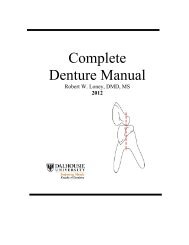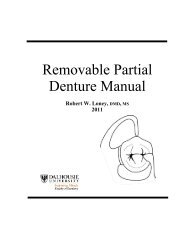Improving The Outcome Of Denture Relining - Removable ...
Improving The Outcome Of Denture Relining - Removable ...
Improving The Outcome Of Denture Relining - Removable ...
You also want an ePaper? Increase the reach of your titles
YUMPU automatically turns print PDFs into web optimized ePapers that Google loves.
–––– Clinical Showcase ––––<br />
Figure 5: For impression-type relining procedures,<br />
mark the centric contacts before and after taking the<br />
impression. Use one colour before taking the impression,<br />
leave the markings on the denture, and use a<br />
different colour after taking the impression. In this<br />
photograph, contacts marked before the impression<br />
(red) closely coincide or overlap with those marked<br />
after the impression (blue).<br />
Figure 6: Relieve any acrylic in the undercut areas of<br />
the base and flange so that the master cast will release<br />
easily from the denture without damage. A dental<br />
assistant in your office or staff in your laboratory can<br />
be trained to do this to expedite the relining procedure.<br />
Figure 7: Shorten any denture flanges that are too<br />
long. Special burs can be purchased to ensure even<br />
reduction of the denture. Provide room for the impression<br />
material, so that the impression does not inadvertently<br />
increase the occlusal vertical dimension. Train<br />
laboratory or auxiliary personnel to reduce the denture<br />
base to improve the efficiency of relining procedures.<br />
Figure 8: Place vent holes throughout the maxillary<br />
base to aid in seating the denture to the proper position<br />
and to prevent separation of the impression from<br />
the denture during removal from the mouth. Lower<br />
dentures rarely require such relief.<br />
www.cda-adc.ca/jcda • September 2007, Vol. 73, No. 7 • 589















